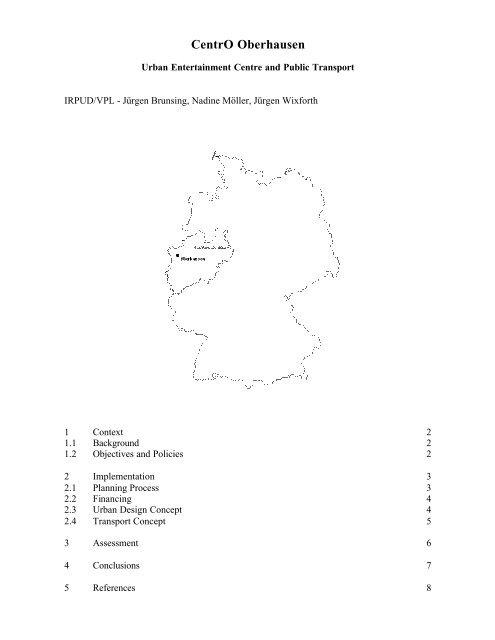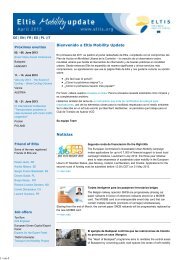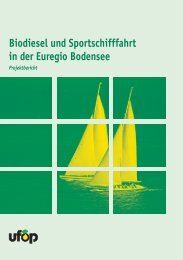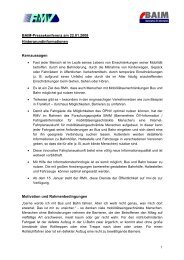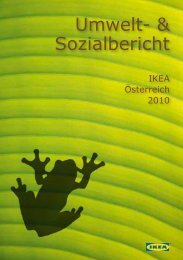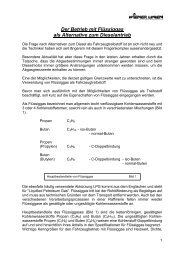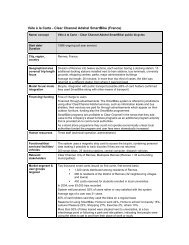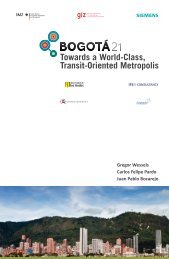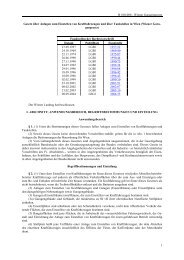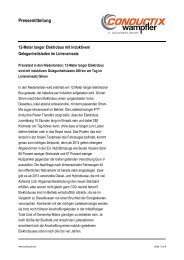CentrO Oberhausen - Eltis
CentrO Oberhausen - Eltis
CentrO Oberhausen - Eltis
Create successful ePaper yourself
Turn your PDF publications into a flip-book with our unique Google optimized e-Paper software.
<strong>CentrO</strong> <strong>Oberhausen</strong><br />
Urban Entertainment Centre and Public Transport<br />
IRPUD/VPL - Jürgen Brunsing, Nadine Möller, Jürgen Wixforth<br />
1 Context 2<br />
1.1 Background 2<br />
1.2 Objectives and Policies 2<br />
2 Implementation 3<br />
2.1 Planning Process 3<br />
2.2 Financing 4<br />
2.3 Urban Design Concept 4<br />
2.4 Transport Concept 5<br />
3 Assessment 6<br />
4 Conclusions 7<br />
5 References 8
TRANSLAND in-depth case study <strong>CentrO</strong> <strong>Oberhausen</strong> 2<br />
1 Context<br />
1.1 Background<br />
The city of <strong>Oberhausen</strong> is an independent municipality in the federal state of Northrhine-<br />
Westphalia in Germany. It is composed of the three historical townships Alt-<strong>Oberhausen</strong>,<br />
Sterkrade and Osterfeld. <strong>Oberhausen</strong> has a population of about 223,000. Its economic situation<br />
is characterised by high unemployment due to the progressive economic structural<br />
change caused by the decline of the mining and steel industries in the Ruhr area.<br />
The <strong>CentrO</strong> <strong>Oberhausen</strong> is a huge shopping mall and urban entertainment centre on the site of<br />
a former steel plant in the Ruhr area. The 98-ha site is divided into different patterns of land<br />
use: 41 ha are assigned to shopping and recreation facilities, 15 ha to commercial businesses<br />
and to residential buildings with 200 residential units, 20 ha to transport and 10 ha to open<br />
space. Only 12 ha remain in industrial use (Microsatt, 1992).<br />
1.2 Objectives and Policies<br />
When the first plans for the <strong>CentrO</strong> were announced, this large-scale investment was expected<br />
to solve many of the economic problems of <strong>Oberhausen</strong>. It was anticipated that the centre<br />
would create 10,000 jobs and attract 30 million annual visitors from a large market area with<br />
a purchasing power of over 150 million Euro per year (Microsatt, 1992).<br />
The motivation behind the decision to build the <strong>CentrO</strong> were therefore primarily economic.<br />
The city was well aware that a large-scale development not connected to the traditional settlement<br />
structure would be controversial, both from the point of view of the traditional city<br />
centres of <strong>Oberhausen</strong> and the neighbouring cities and with respect to environmental objectives,<br />
in particular with respect to sustainable transport. So the urban planners made some<br />
effort to integrate the project into broader planning objectives, such as<br />
- to spatially integrate the <strong>CentrO</strong> with the existing townships,<br />
- to overcome the existing spatial barrier of the former steel plant in the city,<br />
- to attract new types of businesses and services to <strong>Oberhausen</strong>, and<br />
- to compensate for the predominantly car-oriented design of the centre by linking it to the<br />
public transport system of the city (Stadt <strong>Oberhausen</strong>, 1994).<br />
Transport issues ranked high in the debate about the <strong>CentrO</strong>. Figure 1 shows the modal split<br />
in <strong>Oberhausen</strong> in 1995. It can be seen that public transport use in <strong>Oberhausen</strong> with 13% of all<br />
trips is very low, whereas car traffic with 58% has a higher share than even in the traditionally<br />
car-oriented Ruhr area (53%). However, already 84% of <strong>Oberhausen</strong>’s citizens regard traffic<br />
noise as one of the major nuisance of their town. However, it is forecast that private transport<br />
will increase by 17% until 2005. Much of this increase will be due to the <strong>CentrO</strong> because of<br />
its car-orientated concept and the fact that already 65% of all movements are made for consumption<br />
and recreation (Socialdata, 1999).<br />
The response of the City Council to this conflict has been the objective to increase the percentage<br />
of public transport to 30% until 2005 (Strotmann, 1997).<br />
30-9-99 / 2
TRANSLAND in-depth case study <strong>CentrO</strong> <strong>Oberhausen</strong> 3<br />
30-9-99 / 3<br />
Figure 1. Modal shares of <strong>Oberhausen</strong> in 1995 (Source: Socialdata, 1995)<br />
2 Implementation<br />
2.1 Planning Process<br />
The <strong>CentrO</strong> is a joint-venture of the British firms Stadium Group and Peninsular & Oriental<br />
Steam Navigation Company (P&O). Stadium was set up in 1982 as an real-estate investment<br />
company. The focus lies in developing and regenerating brownfield sites. The company is<br />
located in Hull, UK. Its flagship project is the Meadowhall shopping and leisure centre in<br />
Sheffield with a retail area of 150,000 m² on a former steel plant site. Stadium has already cooperated<br />
with P&O during the implementation of Meadowhall. P&O was founded in 1837 as<br />
a shipping company and has today 75,000 employees in 40 countries. Besides shipping, the<br />
company operates in real estates and dock plants. A well-known project of P&O is the Hanseatic<br />
Trade Centre in the docks of Hamburg, Germany.<br />
<strong>CentrO</strong> is under the overall control of Stadium, and P&O contributes with its world-wide experience<br />
in financing, developing and managing retail parks and other commercial estates.<br />
Before Stadium and P&O got in contact with the City of <strong>Oberhausen</strong>, no guiding principles<br />
for the redevelopment of the site had been developed. An earlier attempt of Canadian investors<br />
to use the site for a large shopping mall had been unsuccessful because of political opposition<br />
by the state government.<br />
In 1991 the planning department of the City of <strong>Oberhausen</strong> worked out a framework plan for<br />
the development. Stadium signed a contract with the City of <strong>Oberhausen</strong>, in which the rights<br />
and duties of both partners were regulated. The developers took responsibility for the implementation<br />
of the framework plan, and the city convinced the Thyssen company, the owner of<br />
the site, to sell the property to the Grundstücksentwicklungsgesellschaft <strong>Oberhausen</strong>, a property<br />
development corporation set up and owned by the city (Stadt <strong>Oberhausen</strong>, 1994).
TRANSLAND in-depth case study <strong>CentrO</strong> <strong>Oberhausen</strong> 4<br />
Also in 1992 the Regional Development Plan was modified to get planning permission for the<br />
development of the <strong>CentrO</strong>. This would not have been possible without the strong support of<br />
the state government. The City of <strong>Oberhausen</strong> modified both its preparatory land-use plan and<br />
the legally binding land-use plan for the project and issued the planning permission. In the<br />
course of the modification of both plans, the city contacted the neighbouring cities and was<br />
able to create a consensus for the project within the region. This seems surprising in the light<br />
of the negative impacts the <strong>CentrO</strong> has had on the retail sales in these cities but can be explained<br />
by the light pressure from the state government that stopped criticism.<br />
In parallel with the above planning process, a transport study was commissioned and its results<br />
were incorporated into the existing Traffic Development Plan of <strong>Oberhausen</strong>. The<br />
amendments corrected the assumptions of the plan to take account of the likely effects of the<br />
<strong>CentrO</strong>, added a scenario for sustainable transport, compact urban development and the improvement<br />
of public transport, and proposed measures for the improvement of the pedestrian<br />
and bicycle network, an increase in parking fees and restrictions for car traffic.<br />
One major feature of the improvement of public transport was the conversion of a former<br />
freight railway line into an exclusive right of way for buses and light rail leading from <strong>Oberhausen</strong>’s<br />
main railway and bus stations via the <strong>CentrO</strong> to northern suburbs. In 1993 the construction<br />
of the mall and the conversion of the freight line were started. The opening of the<br />
<strong>CentrO</strong> and the start of operation on the new line both occurred in 1996 (Schmidt, 1995).<br />
2.2 Financing<br />
In general owners of brownfield sites in the Ruhr area are not particularly eager to sell their<br />
former industrial sites because they have to clean the contaminated soil before the sale. To<br />
overcome this resistance, the City of <strong>Oberhausen</strong>, in co-operation with the state of North-<br />
Rhine Westphalia, in 1992 bought the site from Thyssen for about 10 million Euro without<br />
prior decontamination. The contaminated soil was cleaned and infrastructure was created for<br />
about 65 million Euro entirely from public funds (Gansäuer, 1997).<br />
Significant public investments were also made for the transport infrastructure linking the<br />
<strong>CentrO</strong> to the rest of <strong>Oberhausen</strong> and the Ruhr area. To provide good motorway access to the<br />
mall, the nearest motorway exit and the access road leading to it were upgraded for 22 million<br />
Euro. The 135 million Euro investment for the new public transport line were financed jointly<br />
by the City of <strong>Oberhausen</strong> and the state of North-Rhine Westphalia. The elevated bus and<br />
tram stop at the mall was paid for by the developer.<br />
The total investment volume for the <strong>CentrO</strong> amounted to approximately 1,200 million Euro.<br />
The federal state of North-Rhine Westphalia contributed approximately 300 million Euro in<br />
subsidies, as the <strong>CentrO</strong> was seen as a flagship project for the revitalisation of the Ruhr area.<br />
2.3 Urban Design Concept<br />
The layout of the <strong>CentrO</strong> follows familiar principles of greenfield-site shopping mall development.<br />
The main shopping mall with its 70,000 m² of retail space extends as the backbone of<br />
the development across the whole site between major department stores as anchors. Between<br />
the mall and the access road there are multi-level garages (Figure 2).<br />
30-9-99 / 4
TRANSLAND in-depth case study <strong>CentrO</strong> <strong>Oberhausen</strong> 5<br />
30-9-99 / 5<br />
Figure 2. Site plan of the <strong>CentrO</strong><br />
On the opposite side of the mall there is a row of mock-up old-town houses with a variety of<br />
restaurants alongside an artificial canal. Beyond the canal there is an amusement park with<br />
various attractions and more restaurants (Böhler, 1996).<br />
The main entrance to the mall faces a plaza with a pool and the access to the new public<br />
transport station. On the other side of the station there is a new auditorium for musical and<br />
sports events. In the vicinity of the mall is a small office and business park with various old<br />
and new buildings used by research-oriented enterprises. The housing north of the mall has<br />
not yet been implemented.<br />
2.4 Transport Concept<br />
The transport concept of the <strong>CentrO</strong> is mainly car-oriented. The centre is strategically located<br />
near three important motorways (A 42, A 516, A 2). Within a radius of 2,5 km there are<br />
twelve motorway exits leading of the <strong>CentrO</strong>. As mentioned before, one of them, the exit<br />
Osterfeld/Neue Mitte on the A42, and the access road leading to the <strong>CentrO</strong> were upgraded.
TRANSLAND in-depth case study <strong>CentrO</strong> <strong>Oberhausen</strong> 6<br />
Altogether the <strong>CentrO</strong> contains 10,500 free parking spaces. Originally a system with paid<br />
parking was planned, but later dropped. No reasonable possibility to reach the <strong>CentrO</strong> without<br />
using different modes of transport exists for pedestrians and cyclists.<br />
Despite the general car-orientation of the <strong>CentrO</strong>, efforts were made to link the <strong>CentrO</strong> to the<br />
public transport network of the city (Figure 3). A former freight railway line was converted to<br />
an exclusive right of way for buses and light rail leading from <strong>Oberhausen</strong>’s main railway and<br />
bus stations via the <strong>CentrO</strong> to northern suburbs. Modern low-floor buses and trams operated<br />
on the new line first in 90-second intervals, but the frequency has now been reduced because<br />
of sufficient lack of demand (Appel, 1991; Retzko & Topp, 1991; Strotmann, 1997).<br />
3 Assessment<br />
30-9-99 / 6<br />
Figure 3. The <strong>CentrO</strong> in the public transport network of <strong>Oberhausen</strong><br />
It is very doubtful whether <strong>CentrO</strong> is a model to follow, even though it might be preferable to<br />
peripheral greenfield shopping centres.<br />
Three years after its opening, the <strong>CentrO</strong> has proved to be a dangerous competition to retail<br />
and services in the city centre of <strong>Oberhausen</strong> and the other two townships of <strong>Oberhausen</strong>. A<br />
study revealed that 58% of all residents of <strong>Oberhausen</strong> prefer to shop in the <strong>CentrO</strong> instead in<br />
the traditional centres. Losses of customers to the <strong>CentrO</strong> are even observed in the neighbouring<br />
cities of Essen, Mülheim and Bottrop (Wachowiak and Quack, 1999).
TRANSLAND in-depth case study <strong>CentrO</strong> <strong>Oberhausen</strong> 7<br />
However, most residents of <strong>Oberhausen</strong> regard the <strong>CentrO</strong> as an improvement in the shopping<br />
opportunities of their city. 78% evaluate the project as good for the city despite its negative<br />
impacts such as growth of traffic and decline of the city centre. Due to the <strong>CentrO</strong> shopping<br />
facilities rank fourth on the list of positive features of <strong>Oberhausen</strong> (Socialdata, 1995):<br />
(1) quality of life (74%)<br />
(2) leisure facilities (69%)<br />
(3) arts, culture and entertainment (66%)<br />
(4) shopping facilities (63%)<br />
An evaluation of the <strong>CentrO</strong> from a transport point of view has also two sides. On the one<br />
hand, the <strong>CentrO</strong> is clearly car-oriented and by its vast amount of free parking, together with<br />
its good motorway connection, stimulates more long-distance shopping trips by car. On the<br />
other hand, the <strong>CentrO</strong> is well connected to the public transport network of the city and has an<br />
innovative new public transport line with modern low-floor vehicles and frequent service to<br />
the main railway and bus stations.<br />
4 Conclusions<br />
The <strong>CentrO</strong> is a huge shopping mall and entertainment centre on a former steel mill site in the<br />
Ruhr area. The development is isolated without spatial integration into the existing settlements<br />
structure. The <strong>CentrO</strong> draws large numbers of shoppers and visitors from far away at<br />
the expense of neighbouring city centres. The concept for the transport system is mainly caroriented.<br />
However, a former freight railway line was converted to an exclusive right of way<br />
for buses and light rail with a new public transport station at the entrance to the mall. There is<br />
no reasonable possibility to reach the <strong>CentrO</strong> for pedestrians and cyclists without using another<br />
mode.<br />
Because of its central location in the Ruhr area and its good connection with the regional<br />
public transport system, the <strong>CentrO</strong> development may be less detrimental from an ecological<br />
point of view than similar developments on peripheral greenfield sites, which entirely depend<br />
on car access. However, the huge attractiveness of the shopping mall has been very negative<br />
for the economic viability of nearby city centres and certainly is creating more and longer<br />
shopping and recreation trips. A better spatial integration of the <strong>CentrO</strong> into the settlement<br />
structure might have been possible if residential development would have been encouraged<br />
along the new public transport line.<br />
It is very doubtful whether the <strong>CentrO</strong> is a model to follow, even though it might be preferable<br />
to peripheral greenfield shopping centres. However, its example seems to be transferable,<br />
as currently several big shopping and urban entertainment centres are being planned it Germany<br />
and other European countries, mainly at or above railway stations of big cities.<br />
30-9-99 / 7
TRANSLAND in-depth case study <strong>CentrO</strong> <strong>Oberhausen</strong> 8<br />
5 References<br />
Appel H. P. (1991): Untersuchungen zum Verkehrsentwicklungsplan <strong>Oberhausen</strong>. Unpublished<br />
report.<br />
Böhler, S. (1996): Freizeitwandel am Beispiel Neue Mitte <strong>Oberhausen</strong>. Diploma Thesis.<br />
Dortmund: Department of Spatial Planning, University of Dortmund.<br />
Gansäuer, T. (1997): Großprojekte als Strategie der Stadtentwicklung. Diploma Thesis.<br />
Dortmund: Department of Spatial Planning, University of Dortmund.<br />
Micosatt, G.(1992): Neue Mitte <strong>Oberhausen</strong>. Bochum: Gesellschaft für interdisziplinäre Forschung<br />
(G.I.F.).<br />
Retzko & Topp (1991): Verkehrsuntersuchung Neue Mitte <strong>Oberhausen</strong>. Unpublished report.<br />
Schmidt, W. (1995): Neue Mitte <strong>Oberhausen</strong>. Frankfurt am Main: Peter Lang Verlag<br />
Socialdata (1995): Der neue ÖPNV in <strong>Oberhausen</strong> - Mobilität in <strong>Oberhausen</strong>. Band 1-3.<br />
München: Socialdata.<br />
Stadt <strong>Oberhausen</strong> (1992): Untersuchung zum Verkehrsentwicklungsplan <strong>Oberhausen</strong> –<br />
Ergänzungsstudie. <strong>Oberhausen</strong>: Stadt <strong>Oberhausen</strong>.<br />
Stadt <strong>Oberhausen</strong> (1994): Die Neue Mitte <strong>Oberhausen</strong> – Chance und Herausforderung. <strong>Oberhausen</strong>:<br />
Stadt <strong>Oberhausen</strong>.<br />
Strotmann, M. (1997): Mit dem ÖPNV zur Neuen Mitte. Diploma Thesis. Dortmund: Department<br />
of Spatial Planning, University of Dortmund.<br />
Wachowiak, H., Quack H.-D. (1999): Mehrheitlich in die "Neue Mitte". BAG Handelsmagazin<br />
7-8, 18-20.<br />
30-9-99 / 8


